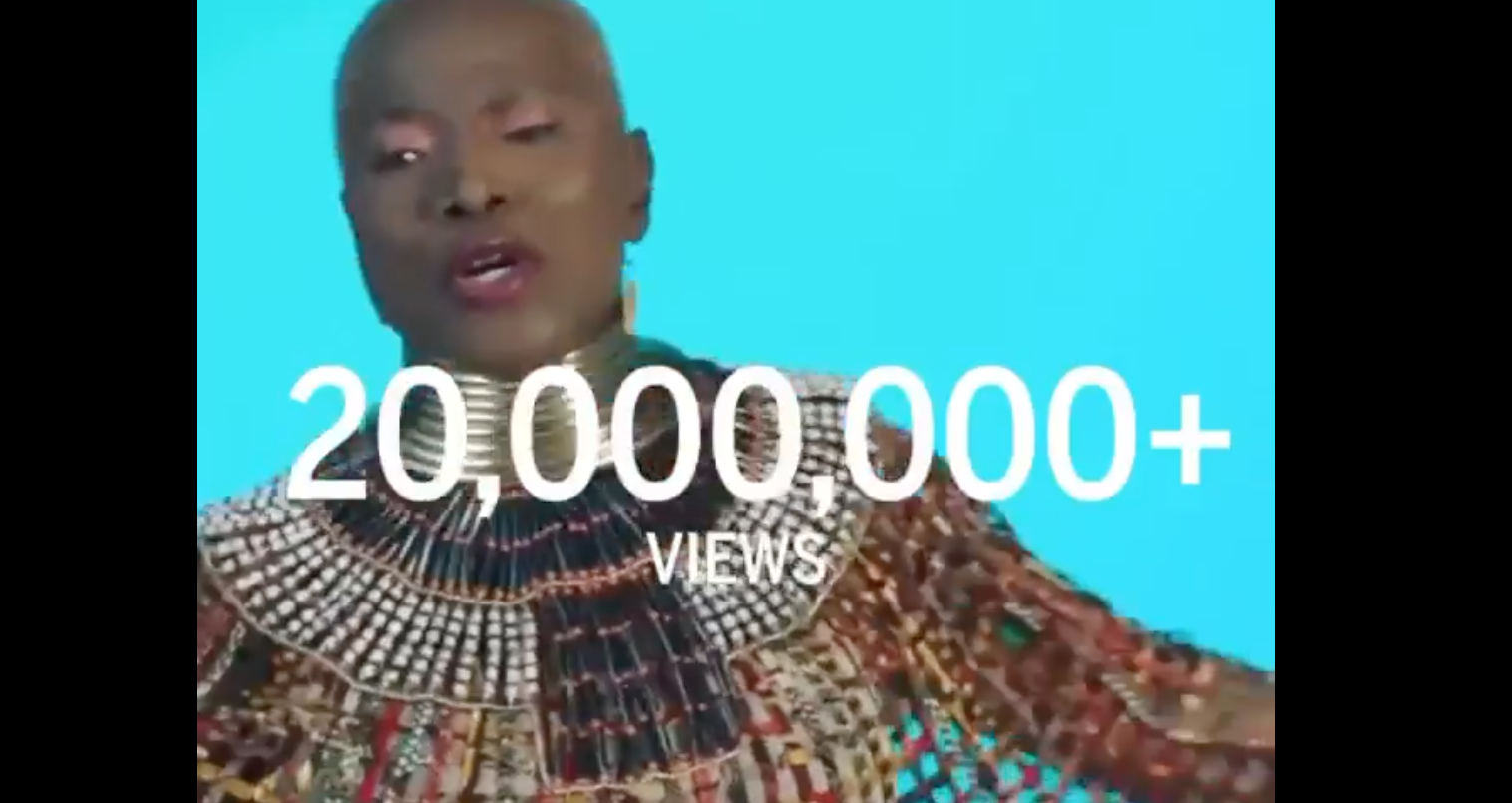CULTURE
MISIC-IN – “Shekere”, the song by Angélique Kidjo and Yemi Alade titled reaches 20 million views on Youtube

The beautiful song of the Nigerian Yemi Alade and the Beninese Angélique Kidjo which has for title “Shekere” made exploits this Tuesday, July 10, 2021. Indeed, released in 2019, the song has just had 20 million views on the YouTube platform. The announcement was made by international star Angélique Kidjo on her Facebook page.
«Shekere» is a song recorded by Nigerian afro-pop artist Yemi Alade and produced by DJ Coublon, from his studio album Woman of Steel (2019). Alade collaborated with Beninese artist Angélique Kidjo on the track.
The success of “Shekere” is mainly due to the collaboration of the two internationally renowned artists. This again the importance of the union of African artists. The great Ivorian artist Tiken Jah Fakoly talking about African unity on all levels “When we are united like the United States it will hurt,” he said.

In an interview with OkayAfrica, Alade said that Kidjo had been an inspiration to her as she grew up. The song took two years to make. The track was produced by DJ Coublon and Kidjo remixed his hit song “Wombo Lombo” on the track. The music video was shot in the UK and Kenya and featured the Maasai tribe of Kenya, the Ushanga women’s group and dancers. It was directed by Ovie Etseyatse. These 20 million views prove once again the hard and above all serious work of these artists.
The two women came together again this year to sing “Dignity”, a title that aims to pay tribute to all those fighting violence committed by the police, inspired by the EndSARS movement in Nigeria. Angélique Kidjo says, “Many people think that police brutality occurs only in America, but it is everywhere.” She added: This song is opposed to brutality, but it also speaks to the need to treat oneself with dignity, to treat nature with dignity and to treat oneself with dignity.walk us with our heads held high?”
CINEMA
BURKINA FASO – Culture and tourism: The 4th edition of Tunnel honors the builders of the shadow

Koudougou, May 31, 2025 (AIB) – The 4th edition of Tunnel, a ceremony for distinguishing cultural and tourist actors in the Central-West region, was held in Koudougou on Saturday, noted the AIB on site.
This annual event, initiated by Adama Badiel, aims to create, according to him, a platform of visibility and support for artists and tourism professionals to allow them to establish themselves on national and international scenes.
The promoter Adama Badiel stressed the importance of this edition, placed under the sign of collaboration, recognition and collective construction. He recalled the fundamental objective of the Tunnel: “to highlight the cultural and tourist talents of the Center-West, these women and men who, often without spotlight or support, nourish our region with their passion, creativity, and determination.”
This year, the event paid a special tribute to its partners, whose support is deemed indispensable. Among the officials present were Jean Noël Bonkoungou, representing the minister of culture, patron of the ceremony, El Hadj Inoussa Bagué, president of the Patronat du Centre-Ouest, Franck Alain Kaboré, CEO of Cinéma Neerwaya, and Ali Bonkoungou, CEO of Salsabil Bâtiment, testifying to the commitment of the private and public sectors.
Despite a slight reduction to five categories in competition this year, due to a limited number of album releases and works meeting the criteria, Adama Badiel ensured that the “Golden Tunnel” category will evolve from next year to expand opportunities while maintaining the quality requirement.
The promoter also launched a call for goodwill because, “we need you to build a true ecosystem where art, heritage, tourism and youth can express themselves, thrive and inspire.” This heartfelt plea highlights the major challenge of the lack of resources to fully support the laureates and optimize their visibility.
Several emblematic figures of Burkinabe cinema, such as Eugène Bayala (Oyou), Sawadogo Alidou (head of the Village of Kikideni), and Rasmané Ouédraogo (Razo), have already been honored in previous editions.
This year, the winners on the artistic side include Mr. Baraka, Tasha, Yololo Junior, and KSB 80.
In the cultural and tourist field, personalities like El Hadj Inoussa Bagué, Franck Alain Kaboré, Rasmané Ouédraogo, Boubacar Berewoudougou (Hôtel Pousga), Catherine Zoma (ISMK), and Salfo Dermé were distinguished, in addition to tributes paid to ancient glories of Burkinabe music such as Pasteur Moussa Josué.
Adama Badiel concluded by stating that “the Tunnel is not a one-time event. It is a movement, an ambition, a bridge between what we are and what we can become. A strong message for the future of culture and tourism in the Center-West.
The boss’s representative, Jean Noël Bonkoungou, reassured the promoter of Tunnel of the support of the ministry.
Source: Information Agency of Burkina
Photo credit: Information Agency of Burkina
CULTURE
SENEGAL – With “COSAAN”, Daara J Family signs a high-flying single

See on the platforms the legendary Senegalese hip-hop group Daara J Family. On May 30, 2025, the band returns with “COSAAN”, a committed single that resonates, with its morning mbalax melodies and gentle flows, as an essential reminder: never forget where you come from. The single has over 80,000 views and 900 comments on YouTube.
“Fan nga cosaanoo?” – Where are your roots?
This question in wolof, almost a supplication, serves as the thread to the new title of Daara J Family. NAACP literally means “origin” or “heritage”. With this single, the iconic duo formed by Faada Freddy and Ndongo D delivers a work that is at once poetic, political and deeply rooted in history, especially that of Senegal. It is also a call to African youth not to forget their origins. And above all to enhance its cultural heritage by walking with pride in the footsteps of the ancients.
Cosaan, between mbalax and rap
Formed in 1994, while still in high school, the members of Daara J Family never gave up their musical identity. Indeed, they have always mixed sharp words, spirituality and pan-African consciousness. In “COSAAN”, they revisit this tradition that is dear to them. In this song, there are traditional sounds (mbalax) and contemporary hip-hop textures, echoing their long-standing belief: rap was born in Africa, traveled, then came back. The refrain, translated into French, is unequivocal: “Le monde et ce qu’il contient / Si tu vas là et que tu l’obtiens / N’oublie pas, n’oublie pas / This is where your origin lies!” A direct appeal to African youth not to give in to cultural amnesia and to keep the memory of ancestors and African identity alive.
When history inhabits the word
Faada Freddy, with his recognizable soul voice among a thousand, hums: “We know where we come from/ What worries us is where we are going…” This lucid concern can only be tempered by an unwavering faith in the values of the elders. Ndongo D, adds in a quick flow: “If you forget yesterday, tomorrow you will be lost (…) You were born here, you come from here, you live here.” It is an anchor cry, a response to uprooting, a warning against forgetting.

Daara J Family: Making sense of the flow
From their first eponymous album in 1998 to Boomerang in 2003 — hailed as one of the best hip-hop albums of the century by The Observer — to Yaamatele in 2020, Daara J Family have always been able to combine the art of flow with that of meaning. Their commitment goes beyond words. They shared the stage with icons such as Public Enemy or Mos Def, and travelled through festivals from Africa to Europe, from WOMAD to Live 8.
COSAAN: a single dedicated to transmission
More than a return, COSAAN is a transmission. It is a manifesto. That of a knowledge, a duty to remember, a pride. At a time when markers are shifting, when crops are being diluted. In an era marked by migration, globalization and multiple influences, Daara J Family reminds us that identity is a foundation, not a burden. That heritage is not nostalgia, but a compass. And they offer a musical compass and identity with this single: Cosaan!
ART
SENEGAL – Ousmane Sow’s massive sculptures enter the Vauban fort at Mont-Dauphin

The monumental works depicting the battle of Little Big Horn, exhibited on the Pont des Arts in Paris in 1999, made the Senegalese artist famous. The installation has just joined the fortress in the Hautes-Alpes for at least ten years.
Muscled warriors meld, horse bumping. Sounds of the fury of battle are heard. Under the impressive curvilinear wooden frame of the old Rochambeau barracks, at the fort of Mont-Dauphin (Hautes-Alpes), is played the battle of Little Big Horn, opposing, in 1876, a coalition of Cheyennes, Sioux and Arapaho to the soldiers of General Custer’s regiment.
In thirty-five monumental sculptures, visible from 6 July, the Senegalese sculptor Ousmane Sow (1935-2016) celebrates the resounding victory of the fragile over the powerful. Deposited in this fortified village for a period of ten years renewable by his widow, the director Béatrice Soulé, this epic installation is well known to the Parisians who discovered it amazed, one day in March 1999, on the Pont des Arts.
The exhibition has remained in the annals with its record attendance – at least 3 million visitors in three months. «An unexpected success», recalls art critic Emmanuel Daydé, then deputy mayor for cultural affairs. For the former physiotherapist born in 1935 in Dakar, who later became an artist, it is consecration. But also, surprisingly, a swan song.
At the moment when Ousmane Sow gains international fame, the art world turns its back on him. Although he was the first African artist recognized in France, none of his successors, to whom he had paved the way, claimed it.
Mayor’s daughter supports her cause
It had all started well. In 1993, the Senegalese sculptor, who two years earlier had been on the cover of Revue noire – a quarterly magazine that revealed a number of African talents – was invited to the major five-year exhibition at Documenta in Kassel, Germany. In 1995, here he is at the Venice Biennale, which is to contemporary art what the Cannes Film Festival is to cinema. The autodidact dreams of an event in Paris.
By chance, he met Hélène Tiberi, daughter of the mayor at the time, Jean Tiberi. Who supports his cause at the City Hall. The location is easy: it will be the Pont des Arts, between the Louvre and the Academy of Fine Arts. It will take diplomatic treasures to convince these two institutions, who have not seen with a good eye the proximity of massive silhouettes imagined by an African artist.Archives «World»: Ousmane Sow questions Bordeaux and politicians
The neighbouring National School of Fine Arts, where figurative art was then taboo, is also pinching its nose. Money is missing. The Havas group had initially promised to contribute to the addition of 5 million francs (the equivalent of 1 million euros today), but its new CEO, Jean-Marie Messier, is sneaking out. Béatrice Soulé moves heaven and earth, finds sponsors and is personally indebted to the tune of 1 million francs. More here
Source: Le Monde




